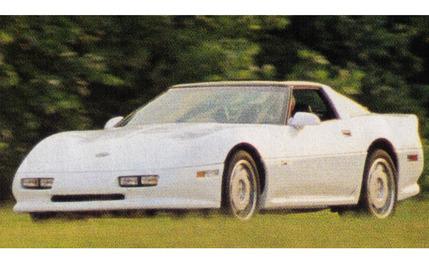 Road Test
Road Test
Five minutes behind the wheel of this bolt of white lightning is enough to prove once and for all that horsepower is like money, sex, and vacation time: a lot is great and too much is better.
The 1992 Chevrolet Corvette LT1 produces 300 horsepower and 330 pound-feet of torque right off the car carrier. Ego-enriching output, to be sure, but barely a trickle charge for John Lingenfelter. Race-engine preparer since 1972, holder of eleven NHRA titles, and builder and seller of high-performance street engines since 1984, Lingenfelter is a committed Corvette crazy to whom 300 horsepower is merely "a good starting point." Proof can be seen in the Lingenfelter creations that have previously graced these pages, including a monster 6.3-liter Vette (December 1989) and a king-of-the-hill quashing ZR-1 (July 1991).
The flyer you see here is the latest power play to spring from Lingenfelter's shop in Decatur, Indiana: a Corvette LT1 automatic modified to produce a ZR-1-like 390 horsepower and 425 pound-feet of torque - the sort of output one might normally associate with, say, a Kenworth. But unlike other Lingenfelter Vettes, which cloak their power beneath stock skins, our test car arrived under gift wrap: a svelte Rick Mears Special Edition body kit penned by styling wizard Larry Shinoda, designer of the 1963 Corvette Sting Ray and the Ford Boss 302 Mustang.
The foundation for the car is Lingenfelter's "Top End" conversion. Lingenfelter removes the stock LT1 5.7-liter V-8 engine, ports the heads, and adds a new camshaft, a larger throttle body, a new intake manifold, and new valves and injectors. He also modifies the stock mufflers to reduce back pressure. Nothing is done to the car's suspension; the only other modification is a shift kit that quickens the automatic's upshifts. The entire job takes about two weeks to complete, costs $9800, and produces a car that is completely emissions legal.
It also produces a car that is completely awe-inspiring. You feel it the moment the engine lights off. The idle is different - a little rougher than stock, a little more impatient, too. A gentle prod of the throttle and the car squirts forward now. It wants to run; holding it back is like trying to walk a caffeine-crazed cheetah on a leash.
When you do let it go, it goes. Bury the throttle and the engine blares, the car hunkers down, and the brutish transmission slams the one-two upshift in a blink. From a standing start, the Top End rips to 60 mph in just 4.3 seconds and blows through the quarter-mile in 12.8 seconds at 110 mph. Our testers report using extra care to achieve such a stellar performance: because the Top End has more power than traction, launching it means using no more than one-third throttle until the tires are hooked up, then easing down the gas only as much as traction will allow.
As one would expect, the Top End pummels the stock automatic-transmission LT1 Corvette, which runs to 60 mph in 5.2 seconds and trips the quarter-mile lights in 13.7 seconds at 102 mph. But the Top End also tromps the 32-valve Corvette ZR-1. Though the ZR-1s we've driven have varied noticeably in performance (our most recent test, in April 1991, noted a 0-to-60-mph run in 4.9 seconds and a quarter-mile time of 13.2 seconds at 108 mph), the Top End betters even the best of them. And even when fully equipped, as our test car was, the Top End sells for about $20,000 less than Chevy's king of the hill.
The Top End has long, long legs, too. Equipped with the aero-slick Shinoda body kit, our test car hammered all the way up to a top speed of 179 mph (without the kit, the car is 2 mph slower). In comparison, the LT1 automatic climbs to 165 mph and the ZR-1 to 171.